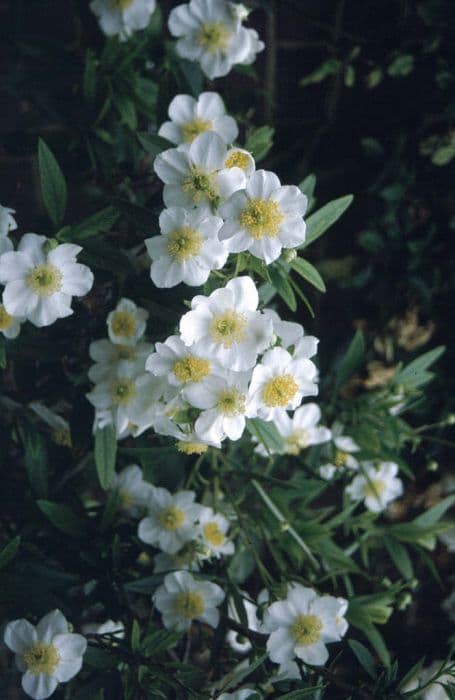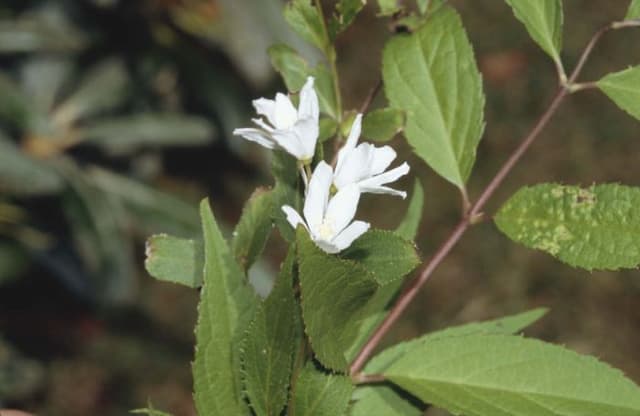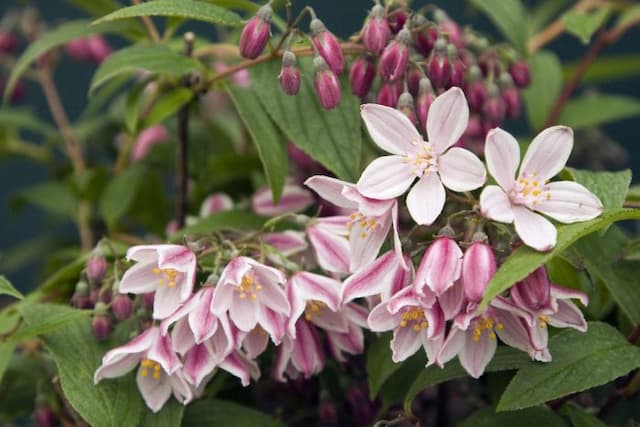Japanese Hydrangea Vine Schizophragma hydrangeoides var. hydrangeoides 'Roseum'

ABOUT
The plant known commonly as the Japanese hydrangea vine 'Roseum' features heart-shaped, serrated leaves that create a lush, green backdrop through which its floral display takes center stage. The flowers resemble those of hydrangeas—clustered, delicate, and frothy—however, in this variety, they bloom in a soft pink hue. These blooms are composed of small, fertile blossoms tightly packed in the center while being surrounded by larger, showy, sterile bracts that generally draw the viewer's attention. The overall appearance of the flowers gives a lace-cap hydrangea effect that adds an air of elegance to the plant. In addition, as the plant matures, the bark becomes attractively flaky, adding to its visual interest even when the vine is not in bloom. The Japanese hydrangea vine 'Roseum' clings and climbs using aerial roots, which makes it a choice addition for covering walls, trellises, or other vertical structures within a landscape.
About this plant
 Names
NamesFamily
Hydrangeaceae.
Synonyms
Japanese Hydrangea Vine, Japanese Climbing Hydrangea, False Hydrangea Vine, Roseum Japanese Hydrangea Vine.
Common names
Schizophragma hydrangeoides 'Roseum'
 Toxicity
ToxicityTo humans
Japanese hydrangea vine, known scientifically as Schizophragma hydrangeoides var. hydrangeoides 'Roseum', is not known to be toxic to humans. There is limited information available on the toxicity of this plant, and it is generally not considered to be a concern for human poisoning. However, as with any plant, individual allergies or sensitivities could potentially occur, and it's always advised to avoid ingesting plants that are not designated as food items.
To pets
Japanese hydrangea vine is not commonly reported to be toxic to pets, including dogs and cats. There is no well-documented evidence indicating that the ingestion of this plant by pets commonly results in poisoning. Nevertheless, ingestion of non-food plants can potentially cause gastrointestinal upset in pets, such as vomiting or diarrhea, due to the irritation of the digestive tract. As with humans, it is usually wise to prevent pets from consuming ornamental plants.
 Characteristics
CharacteristicsLife cycle
Perennials
Foliage type
Deciduous
Color of leaves
Green
Flower color
Pink
Height
30 feet (9 meters)
Spread
6 feet (1.8 meters)
Plant type
Climber
Hardiness zones
5
Native area
Japan
Benefits
 General Benefits
General Benefits- Aesthetic Appeal: Adds visual interest with its pink-tinged white flowers and attractive foliage.
- Shade Tolerant: Grows well in shady areas where other plants may struggle.
- Vertical Interest: Climbs up trees and walls, providing a vertical element in garden design.
- Seasonal Interest: Offers changing beauty throughout the seasons, from spring blooms to fall foliage.
- Wildlife Attraction: Flowers attract pollinators like bees and butterflies, supporting biodiversity.
- Easy to Grow: Generally requires low maintenance, making it ideal for gardeners of all skill levels.
- Adaptability: Can thrive in various soil conditions with adequate drainage.
- Large Coverage: Capable of covering large spaces, which can be useful for hiding unsightly walls or fences.
- Deciduous Nature: Loses leaves in winter, allowing sunlight through when it's most desired.
- Hardiness: Tolerant of cold temperatures, surviving in climates with cold winters.
 Medical Properties
Medical PropertiesThis plant is not used for medical purposes.
 Air-purifying Qualities
Air-purifying QualitiesThis plant is not specifically known for air purifying qualities.
 Other Uses
Other Uses- Japanese hydrangea vine is sometimes utilized in thematic gardens, such as fairy or fantasy-themed gardens, due to its whimsical appearance that resembles old, climbing ivy-covered walls.
- With its climbing nature, gardeners use the plant to create living curtains on pergolas or trellises, providing shade and aesthetic appeal.
- Creative landscape artists sometimes employ this plant in topiary gardens, training it to cover shapes and create living sculptures.
- In crafting, the dried flowers of Japanese hydrangea vine can be used in flower arrangements, wreaths, and potpourri for their delicate texture and intricate patterns.
- The vine's rustic and rugged bark texture can be used in nature photography as a unique backdrop or as an interesting subject itself.
- Some education programs use the plant to teach botany and horticulture students about climbing plants and their mechanisms for ascent.
- In large aquarium or terrarium setups, parts of the Japanese hydrangea vine can be used to create natural-looking habitats for climbing animals.
- Japanese hydrangea vine can sometimes be included in outdoor sensory gardens, as its leaves and flowers have a unique texture to explore.
- During fall, the foliage of the Japanese hydrangea vine turns into a colorful display, which can be used by landscape photographers to enhance their autumnal scenes.
- For those interested in sustainable living, the vine can be trained to grow over unsightly structures, like compost bins or water tanks, to blend them into the garden.
Interesting Facts
 Feng Shui
Feng ShuiThe Japanese hydrangea vine is not used in Feng Shui practice.
 Zodiac Sign Compitability
Zodiac Sign CompitabilityThe Japanese hydrangea vine is not used in astrology practice.
 Plant Symbolism
Plant Symbolism- Delicate Beauty: The Schizophragma hydrangeoides 'Roseum', commonly known as the Japanese hydrangea vine, features delicate and intricate blossoms, often symbolizing the finer and more graceful aspects of beauty in the plant world.
- Perseverance: As a climbing vine, it represents the ability to overcome obstacles and persist in the face of challenges, much like it climbs and covers walls and trees.
- Heartfelt Emotions: Similar to hydrangeas, the Japanese hydrangea vine is often associated with the expression of genuine, heartfelt emotions due to its heart-shaped foliage and the emotive quality of its blooms.
 Water
WaterJapanese hydrangea vine should be watered thoroughly, ensuring that the soil is moist but not waterlogged. Water the plant once a week, providing about 1-2 gallons per watering depending on weather conditions, such as increased frequency during hot, dry spells to maintain consistent soil moisture. Reduce watering in the fall and winter when the plant is dormant. Always check the top few inches of soil for dryness before watering again to prevent overwatering.
 Light
LightJapanese hydrangea vine thrives in dappled sunlight or partial shade; direct afternoon sun can be too intense and may scorch the leaves. The ideal spot for this plant is one where it receives bright, indirect light in the morning with protection from harsh midday sun, such as on the east or north side of a building or beneath the light shade of taller trees.
 Temperature
TemperatureJapanese hydrangea vine grows best in temperatures between 60°F and 80°F. It can handle a minimum temperature around 40°F. However, it should be protected from freezing temperatures below 32°F. The ideal temperature range should be maintained to ensure healthy growth.
 Pruning
PruningPrune Japanese hydrangea vine to shape it, control its size, and remove any dead or damaged growth. The best time to prune is late winter or early spring before new growth begins, typically once a year. Always make clean cuts and try to prune in such a way that encourages airflow and light penetration within the plant's structure.
 Cleaning
CleaningAs needed
 Soil
SoilJapanese Hydrangea Vine prefers well-draining, fertile soil with a pH of 5.5 to 6.5. A mix of loam, peat, and sharp sand in equal parts works well to provide the necessary drainage and nutrients. Regular organic matter enrichment and mulching help maintain soil health.
 Repotting
RepottingJapanese Hydrangea Vine is typically not repotted often as it's grown mainly in the ground; however, young potted plants can be repotted every 2-3 years to encourage growth.
 Humidity & Misting
Humidity & MistingJapanese Hydrangea Vine thrives in a moderately humid environment, similar to its natural woodland habitat, but it is quite adaptable and does not require specific humidity levels.
 Suitable locations
Suitable locationsIndoor
Use a large pot, bright indirect light, and keep soil moist.
Outdoor
Plant in partial shade, mulch well, and protect from strong winds.
Hardiness zone
5-9 USDA
 Life cycle
Life cycleSchizophragma hydrangeoides var. hydrangeoides 'Roseum', commonly known as Japanese Hydrangea Vine, begins its life as a seed, which germinates in moist, well-drained soil, often in shaded areas. Upon germination, it develops a root system and shoots, eventually growing into a climbing vine with heart-shaped leaves. The vine produces clusters of small, non-showy true flowers surrounded by showy pink or rose-colored bracts in mid to late summer. After pollination, typically by insects, the flowers develop into small, dry capsules that eventually release seeds, allowing for the continuation of its life cycle. The vine may experience a period of dormancy during winter, especially in cooler climates. Throughout its life, the Japanese Hydrangea Vine will climb trees, walls, or other supports, reaching substantial heights and widths over the years.
 Propogation
PropogationPropogation time
Spring to summer
Propogation: The Japanese hydrangea vine, Schizophragma hydrangeoides var. hydrangeoides 'Roseum', is best propagated during its active growth period, typically in spring or early summer. The most popular method of propagation for this plant is by layering. To propagate by layering, a low-growing branch is bent to the ground and partially buried in soil while still attached to the parent plant. The buried portion is often wounded or notched to encourage root formation. It is generally secured with a stake or a heavy rock to maintain good soil contact. Over a period of several months, usually within a growing season, roots will develop at the point of contact with the soil. Once a strong root system is established, the new plant can be severed from the parent and transplanted to a desired location.








![Hydrangea [Strong Annabelle]](/_next/image?url=https%3A%2F%2Fplants-admin.emdemapps.com%2Fimages%2Fplants%2F%2Fimages%2F604b54db37d34.png&w=640&q=75)
